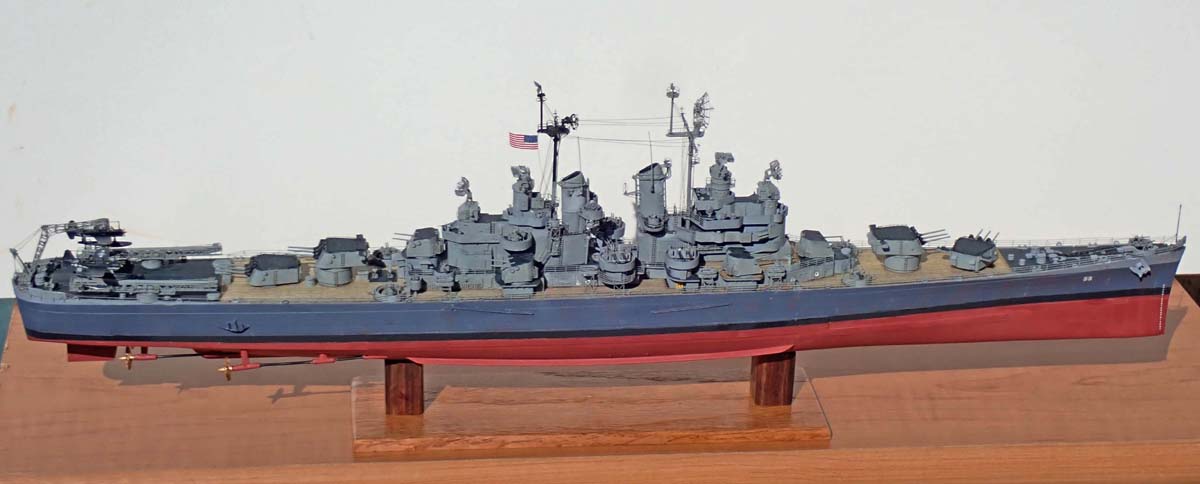
1/350 USS Cleveland CL-55 (Very Fire)
|
|

1/350 USS Cleveland CL-55 (Very Fire)
I purchased this kit last year and then waited patiently for Very Fire to release its detail set, which it did perhaps 6 months or more later. This is, to my knowledge, the first 1/350 scale plastic kit of any American light cruiser, and it is in most ways a superbly engineered venture, both for the plastic kit and for the extensive photoetch detail set that followed. An interesting (and perhaps somewhat wasteful) aspect of the plastic kit is that there are quite a few duplicated parts, many extra (unused) parts, and several whole frets that are included but completely unnecessary. I suspect this is so that future kits of the same cruiser class (or which there were many) can be issued with some of the extra parts being used for them. The detail set for the USS Cleveland is quite specific to that kit, and includes masts, yardarms, ladders, railings, and all brass gun barrels (6-in., 5-in., 40 mm and 20 mm), though the 20 mm barrels are somewhat overscale in diameter. There are many small resin parts: 6-in. blast bags, the 40 mm quad and twin mounts, the breech blocks for the 40 mm barrels, searchlights, cockpits for the two Kingfisher floatplanes, rangefinders for three of the four main gun turrets, two paravanes, radar bases and whip antenna bases. There are a few engineering errors in this kit; most significantly, the brass foremast is about 1 cm too short, but I was able to graft that additional length from the lower end of the plastic kit’s corresponding part.The plastic kit includes a single small fret of railing, which is exclusively for the superstructure, and will be needed even if the detail set is purchased, as there are few duplications here. Decals for the ship's hull number, a rather oversized American flag, and wing and fuselage emblems for just one of the Kingfishers are included.
Parts fits of the plastic kit are uniformly excellent, especially the deck to the 1-piece full hull, and though the gun turrets are intended to be glued into place, with a little ingenuity I was able to fit plastic or wooden pieces below the deck to secure them in place while still permitting some rotation (limited in the case of the broadside twin 5-in mounts). Also, the tiny holes in the resin 40mm breech blocks meant to receive the corresponding 40mm brass barrel ends are too narrow and too short and required careful drilling out with a 0.3 mm bit. The plastic kit includes a color scheme for the late 1945 configuration (standard Measure 22), but the excellent wood deck provided with the detail set was bare wood, not colored in 20B deck blue, which means using it unpainted would imply that the war in the Pacific was over and the ship was preparing for peacetime. A paper insert in the plastic kit attempts to explain the various configurational changes to different members of the Cleveland class light cruisers, stating that, originally, boat cranes and a “boat farm” were present earlier in the war, though these had been eliminated by 1945 (and Very Fire’s model depicts the ship in this form – motor whale boats are present on the sprues but not to be used in this kit, and no boat davits or cradles provided). The number of 20 mm and 40 mm guns generally increased throughout the war on various ships, but in this kit the 20 mm galleries amidships between the funnels are absent. The detail set assembly instructions are in fairly large print on four large sheets of glossy white paper, although the precise assembly of some parts (such as radars) will require some preparation to be done properly. Virtually all of the complex assemblies (e.g., radars, catapults, masts and catapult crane) fit together quite well.
For painting, I used True North 5N and Hull Red; my 5H had mostly congealed so I ordered a bottle of water-based 5H from Mission Models. This paint has no odor (a significant advantage when airbrushing) but it doesn’t cover nearly as well as enamel-based paints, and airbrushing it takes longer as multiple layers must be applied to achieve opacity. At least cleanup is quick and easy.
